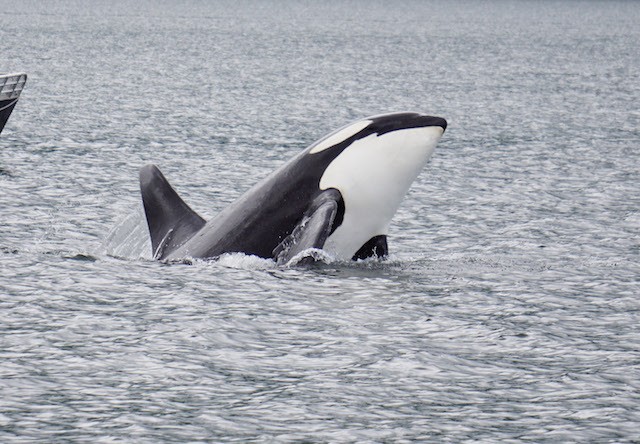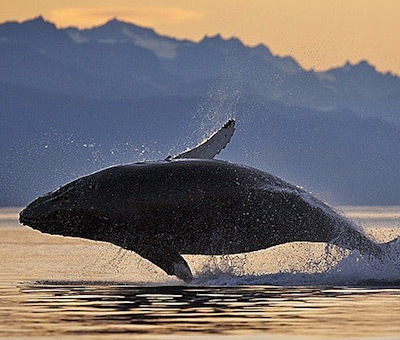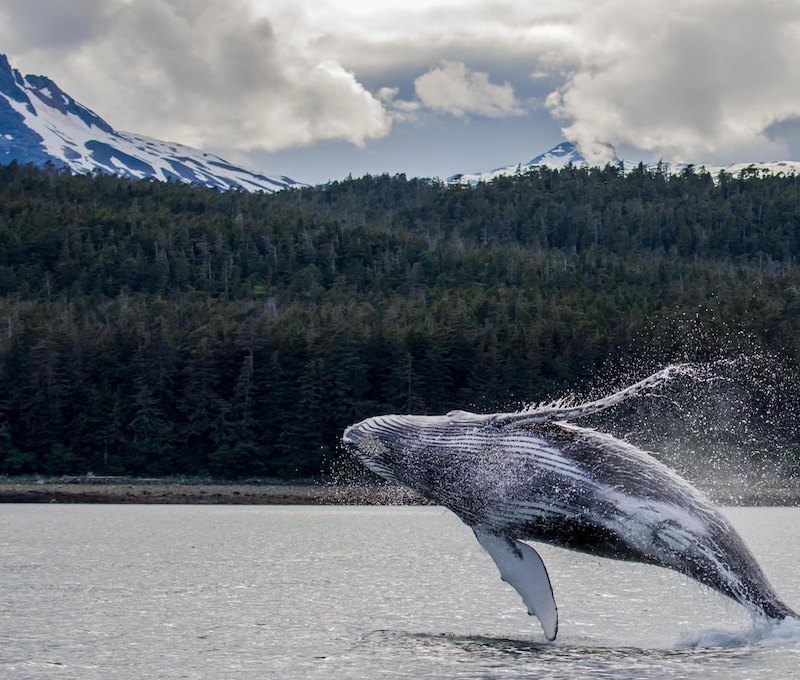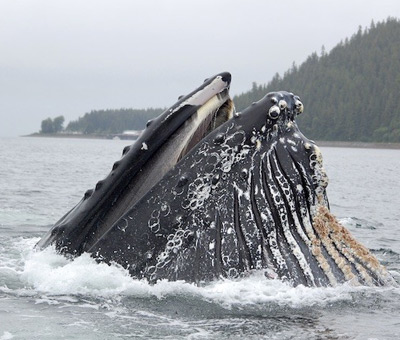Last Updated: Dec 28, 2025
Alaska’s seafood-rich waters are the summer home of many different kinds of whales. Though endangered worldwide, the most commonly seen whale in Alaska is the humpback. These gentle giants are around 49 feet in length and can weigh up to 29 tons, aka 58,000lbs! North Pacific Humpbacks leave their chilly Alaskan feeding grounds in September, heading south to temperate or tropical waters near Mexico, Hawaii, and in the western Pacific near Japan.
Humpback Whales
The humpbacks travel nearly non-stop for 6-8 weeks to reach warmer breeding grounds, with those heading to Hawaii covering nearly 3,000 miles! At 6,000 miles for the annual round trip, this is one the largest migrations for mammals. While in the warmer waters, Humpbacks mate, give birth, and nurture their calves. At birth, calves are can be about 10-15 feet in length. Come April, they’re moving again, back up to Alaska, where in May they will concentrate in several areas including Southeast Alaska, Prince William Sound, Kodiak, the Barren Islands, and along the Aleutian Islands.
Orcas (Killer Whales)
The second whale that you are could encounter during your Alaskan adventure is the Killer Whale, or Orca. Compared to the Humpback, Killer Whales are much smaller in size only coming in at about 27 feet. Their size doesn't stop them from hunting larger prey; Killer Whales work together in pods to hunt Humpback whales, and pretty much anything else in marine waters. They’ve certainly earned their “killer” name!
Orcas don’t take on the journey of Humpbacks though, they instead seem to go wherever the food is, preferring colder waters. They are one of the few mammals that move freely between hemispheres. Those in Alaska move north throughout the Bering Strait in the spring, as the ice retreats. They leave the Beaufort and Chukchi areas in the fall, when the ice advances. Killer whales can be seen in southeast Alaska between early May and early June with whales more sporadically spotted in June through September. They can be seen in the waters of Resurrection Bay, near Seward, as well as throughout Southeast Alaska, with the largest abundance found near Juneau and Ketchikan.
Gray Whales
Gray Whales are another gentle giant among the species. Like Humpbacks, they enjoy their summers feeding in Alaska. At 45 feet long, they are also not hunters but are extremely loyal. Known for fiercely protecting their calves, they earned the name “Devil Fish” by Yankee whalers, whose boats were often attacked when they got too close to their young.
These whales are the official winner of longest migration, at 5,000-7,000 miles each way! In October, they leave their feeding grounds in Alaska’s Bering and Chukchi seas. They swim south for 2-3 months before reaching their calving lagoons in Baja California, Mexico. The whales return north in mid-February, passing through Ketchikan, Sitka, Kodiak, and Seward during the months of April and May, before arriving back at their feeding grounds. Not all Gray Whales migrate all the way north, with some sticking to the coasts of British Columbia, Washington, Oregon, and California. Locals call them “resident whales”, and look forward to their arrival.
Belugas
Belugas (whose closest living relative is the Narwhal!) are one more whale that migrates through Alaska’s waters. They can be seen in Cook Inlet, Bristol Bay, eastern Bering Sea, eastern Chukchi Sea, and Beaufort Sea. The Bristol Bay and Cook Inlet populations are believed to remain within their respective areas year-round. The eastern Bering Sea, eastern Chukchi Sea, and Beaufort Sea populations winter in the Bering Sea.
Blue Whales
A final whale of Alaska is the Blue Whale, the largest mammal ever known to have lived on Earth. (100 feet long and 200 tons!) They can be seen in open waters of the northern and eastern portions of the Gulf of Alaska in July and August before wintering in Mexico, Central America, and the western and central Pacific.
More whale species that migrate through Alaska are: Baird’s Beaked, Bowhead, Cuvier’s Beaked, Fin, Minke, North Pacific Right, Sei, Sperm, and Stejneger’s Beaked. To view them in action, consider a Juneau Whale Watching or Icy Strait Whale Watching Tour.
Alaska Whale Watching FAQs:
1. What are the best Alaska whale watching tours?
Juneau Whale Watching Tours are the most popular, because seeing whales is guaranteed. The Icy Strait Whale Watching Tour is also a popular choice.
2. What is the best port for whale watching?
Juneau is the best port for whale watching, because seeing whales is 100% guaranteed. Icy Strait is also a good choice for whale watching, because whales are abundant (though not guaranteed).
3. When is the best time for whale watching in Alaska?
The best time to see whales is June through August. Late July and August is especially good, as this is when the humpback whales begin "Bubble Net Feeding" and you can see 10-12 whales jumping out of the water at once.

 Mendenhall Glacier
Mendenhall Glacier Whale Watching
Whale Watching Dog Sledding
Dog Sledding Salmon Bake
Salmon Bake Helicopter
Helicopter Kid-Friendly
Kid-Friendly Kayak
Kayak Adventure
Adventure Train
Train Yukon
Yukon Rafting
Rafting Misty Fjords National Monument
Misty Fjords National Monument Boat
Boat Fishing
Fishing Bear & Wildlife
Bear & Wildlife Animal & Wildlife
Animal & Wildlife






